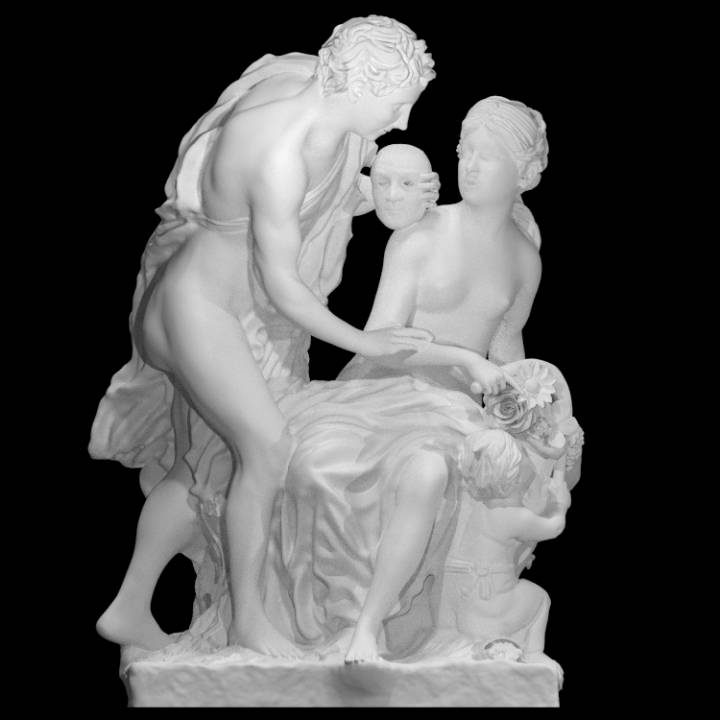
Vertumnus and Pomona
myminifactory
Vertumnus was a versatile god who could transform into any form he desired, and in this depiction, he is shown courting the nymph Pomona. He gained her attention by disguising himself as an elderly woman, and then proceeded to plead his case. When this approach failed, he revealed his true identity as a youthful deity; here, he is seen removing his mask. Vertumnus and Pomona was probably originally designed for Canons in Middlesex, the estate of the Duke of Chandos, as a companion piece to a similar group created by Scheemakers. After Canons was demolished, the group moved to Stowe in Buckinghamshire, where it served as a garden sculpture until it was sold in 1921. The two groups were clearly intended to be viewed together. In 1797 and 1799, they were noted as being in the garden. By 1848, when the first Stowe sale took place, they had been moved to the South Portico. Because the sculpture stood outdoors for many years, its surface is severely weathered. Delvaux was a Dutch sculptor who worked primarily in England from 1717 to 1728, often partnering with Peter Scheemakers (1691-1781). During the 18th century, garden sculptures became increasingly popular in Britain. Statues, monuments, temples, and follies populated extensive landscaped gardens. Mythological subjects were abundant, such as this Vertumnus and Pomona, partly because patrons and collectors were emulating classical and Italian Renaissance gardens. Vertumnus and Pomona is a tale of seduction and deception from Ovid's Metamorphoses, a popular source for imagery in 17th-century Dutch painting. Vertumnus, the Roman god of seasons and change, assumed multiple guises as he attempted to win over the recalcitrant wood nymph Pomona. Govaert Flinck has painted the moment in their courtship when Vertumnus, disguised as an elderly woman, is speaking on his own behalf to a puzzled Pomona. The two figures are dramatically pressed to the front of the picture plane in a tightly defined space and are set against a dark background of tree trunks and exposed roots. Although the setting is intimate and the figures are close enough that their knees almost touch, there is an unmistakable distance between them. Pomona, seated on the right, is portrayed as a young woman with a ruddy complexion, elegantly dressed in white satin, with a richly embroidered bodice. She leans to her left, her cheek pressed heavily into her hand, her gaze directed off into the distance. Whether she is listening intently to her companion or dreamily lost in thought is impossible to determine. On the left, Vertumnus is portrayed in mid-gesture, "her" right hand moving towards Pomona; her left, turning back to herself. In contrast with Pomona's youthful complexion, Vertumnus' coarse skin and features bear evidence of age. What is not immediately clear, however, is Vertumnus' gender. While the rust-colored clothing and turban-like headdress suggest feminine attire, there is a masculine quality in both his face and hands. Flinck, exercising his culture's appreciation for subtle innuendo, solves the mystery for the attentive observer who notices the walking stick leaning against the inside of Vertumnus' thigh. Gallery location: Sculpture, Room 23, The Dorothy and Michael Hintze Galleries, case FS This object is part of "Scan The World". Scan the World is a non-profit initiative introduced by MyMiniFactory, through which we are creating a digital archive of fully 3D printable sculptures, artworks, and landmarks from around the globe for public access. Scan the World is an open-source community effort; if you have interesting items nearby and would like to contribute, email stw@myminifactory.com to learn how you can participate. Courtesy of the Victoria and Albert Museum, London
With this file you will be able to print Vertumnus and Pomona with your 3D printer. Click on the button and save the file on your computer to work, edit or customize your design. You can also find more 3D designs for printers on Vertumnus and Pomona.
